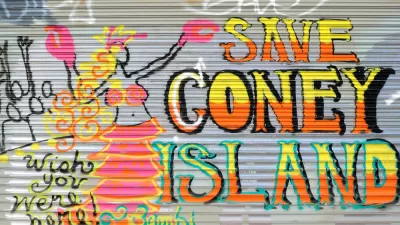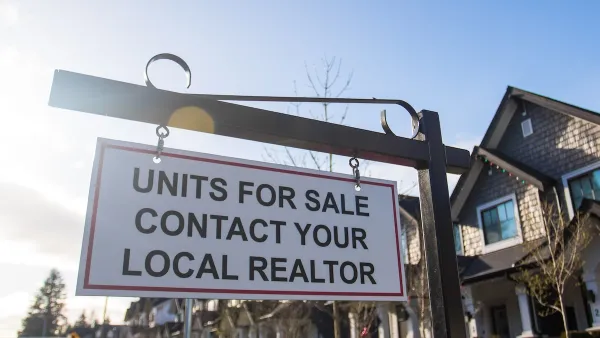Designer Rachael Smith argues that a Puritan attitude toward color explains why so many American cities are clad in grays and browns, and links the gray-ification of cities to their gentrification.

Walk around your neighborhood and count the house or building colors you see. Four million hues of grey? Check. Lots of tans and browns? Definitely. An abundance of white and off white? Absolutely. The occasional red door? You got lucky.
Even many beautiful brick buildings are muted canvases just waiting for a touch of hue and vibrancy—opportunities in the window frames, doors, and accents. While not all buildings and homes should be altered, particularly those with historic value, there are many structures in cities that would look far nicer with a touch of color. Is that subjective? Of course, it is! But I believe it is important we all take a hard look at our collective “fear of color,” manifested throughout our urban palette, and have an honest discussion about what we can do to cheer up our cities.
Much of cities’ avoidance of color is rooted in colonial and Puritan roots. In some European cultures, white is often seen as pure and good, while color has often been linked to the primitive and the superficial. Goethe, a German playwright and novelist, captured the origins of the European anti-color stance when he wrote, “Men in a state of nature, uncivilized nations and children, have a great fondness for colors in their utmost brightness,” whereas “people of refinement” avoid such vivid and saturated colors. This historic association of good taste with quiet colors has led to neutrals as a sign of moral superiority.
These negative associations with color still exist today and are often codified in our communities. Just check out the painting guidelines in a nearby homeowner’s association or within municipal design guidelines and you’ll see this fear in play. When color is used, there is a sense that it must be controlled—a pop of neutral color is acceptable, but a large dose of color is oftentimes restricted.
We also see this tendency to neutrals playing out in neighborhoods that are gentrifying—the older houses are rehabbed or replaced with homes that are typically white or shades of gray. In Chicago’s Pilsen neighborhood, a 2019 exhibit entitled Peeling off the Grey at the Mexican Museum of Art explored this topic—a commentary on the new homes and homeowners stripping away the color from this traditional Mexican-American neighborhood.
With this whitewashing comes another very worrisome trend—the painting over of bright and beautiful murals that have historically celebrated the culture of a neighborhood. In one of the most notorious examples in Pilsen, a developer painted over a famously colorful mural by artist Ray Patlan at the former Casa Aztlan community center. Following community outrage, the developer commissioned Patlan to return and recreate a portion of the mural on its façade, but on only one side of the building.
[Read more at the source article, below.]
FULL STORY: American Cities Should Be More Colorful

Planetizen Federal Action Tracker
A weekly monitor of how Trump’s orders and actions are impacting planners and planning in America.

Map: Where Senate Republicans Want to Sell Your Public Lands
For public land advocates, the Senate Republicans’ proposal to sell millions of acres of public land in the West is “the biggest fight of their careers.”

Restaurant Patios Were a Pandemic Win — Why Were They so Hard to Keep?
Social distancing requirements and changes in travel patterns prompted cities to pilot new uses for street and sidewalk space. Then it got complicated.

California Homeless Arrests, Citations Spike After Ruling
An investigation reveals that anti-homeless actions increased up to 500% after Grants Pass v. Johnson — even in cities claiming no policy change.

Albuquerque Route 66 Motels Become Affordable Housing
A $4 million city fund is incentivizing developers to breathe new life into derelict midcentury motels.

DC Area County Eliminates Bus Fares
Montgomery County joins a growing trend of making transit free.
Urban Design for Planners 1: Software Tools
This six-course series explores essential urban design concepts using open source software and equips planners with the tools they need to participate fully in the urban design process.
Planning for Universal Design
Learn the tools for implementing Universal Design in planning regulations.
Heyer Gruel & Associates PA
JM Goldson LLC
Custer County Colorado
City of Camden Redevelopment Agency
City of Astoria
Transportation Research & Education Center (TREC) at Portland State University
Camden Redevelopment Agency
City of Claremont
Municipality of Princeton (NJ)





























